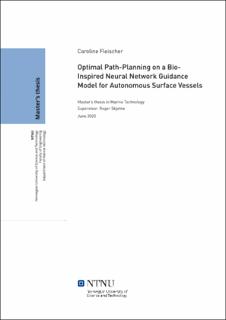| dc.description.abstract | Planlegging av en trygg og kollisjonsfri bane er avgjørende når graden av autonomi i skip øker. Det gjøres med utgangspunkt i en modell av omgivelsene, som her har vært i form av et bio-inspirert nevralt nettverk. En strategi for å finne en mulig bane i dette landskapet er hybrid A*. Denne algoritmen tar hensyn til at området skipet beveger seg i er kontinuerlig, samt fartøyets iboende begrensninger i form av svingradius. To ulike metoder for å danne søketreet ble utviklet: Enten ved bruk av rette linjestykker med fast lengde, eller med buesegmenter gitt av fartøyets minste oppnåelige svingradius. I tillegg ble to kostfunksjoner evaluert, hvorav en er den Euklidiske avstanden til mål, mens den andre var justert for nevral aktivitet og inkluderte en straff på endring i søkeretning. Hybrid A* algoritmen ble testet gjennom simuleringer, og bruk av rette linjestykker sammen med førstnevnte kostfunksjon viste seg å være mest effektiv med tanke på antall noder som evalueres ved hvert søk etter en bane.
Trygg ferdsel og forutsigbare handlinger i situasjoner med møtende trafikk sikres ved å få skipet til å følge konvensjonen om internasjonale regler til forebygging av sammenstøt på sjøen, COLREG. Strategien var å definere et område framfor det møtende skipet som ikke skulle krysses av skipet under kontroll. Området ble beregnet utfra relativ vinkel og avstand mellom skipene, slik at manøvrer passende til den gjeldende situasjonen ble igangsatt. Simuleringer viste at strategien fungerte i ulike situasjoner, men en alvorlig svakhet er at skipet kan bli fanget inne i området som skal unngås, som igjen kan resultere i potensielt farlige situasjoner. En mulig løsning er å benytte en annen geometrisk form enn et rektangel og i det minste sikre at skipet har en mulig utvei.
Baneplanleggeren ble integrert som en del av et helhetlig autonomt system. Det inkluderte en banegenerator, en estimator, samt et kontrollsystem. Utfra veipunktene gitt av baneplanleggeren, var banegeneratoren ansvarlig for å definere en sammenhengende og glatt bane tatt i betraktning fartøyets iboende begrensninger. Til dette ble Bézier-kurver benyttet. Kontrollsystemet var ansvarlig for at skipet faktisk fulgte banen, ved å beregne nødvendige krefter og moment som propulsjonssystemet måtte generere. Estimatoren viste seg å gi nøyaktige estimater av skipsposisjonen, selv med støyete målinger, og disse ble benyttet av baneplanleggeren. Hybrid A* med rette linjestykker er trolig den mest lovende metoden i et slikt system, ettersom den er forutsigbar i det at den gir veipunkter med konstant avstand fra hverandre. | |
| dc.description.abstract | Intelligent path-planning for surface vessels is crucial when enhancing their level of autonomy – or self-government. Path-planning is typically based on a guidance model that replicates the operational environment according to a priori knowledge and perceptual information. Changes in the model prompt replanning of the path, which is intrinsic to collision avoidance and the execution of a safe voyage. A bio-inspired neural network was explored to serve as the guidance model. The model seems promising in how information can be fused into a neural activity landscape. A downside is related to the steepness of the landscape, yielding minimal differences in the activities of neurons associated with free space, and thus increasing the difficulty of determining the better waypoints.
Waypoints were determined by a path search strategy. A mixed-integer program was formulated, but did not produce practicable outputs. Nevertheless, to promote system reactivity, the receding horizon approach was proceeded with and combined with hybrid-state A* path search. Advantages of the hybrid A* algorithm include that it considers the continuous nature of the search space as well as nonholonomic constraints of the vehicle. Expansions of the search tree were performed either with straight lines of a predefined length or with arcs based on the vessel's minimum turning circle, and according to an heuristic estimate of the distance to the target. The latter was either calculated as the Euclidean distance, or a modification based on neural activities and with a penalty on changes in search direction. Straight-line expansions together with the former heuristics finished in the shortest time, but the latter heuristics generally yielded paths with less turns. Although any combination of heuristics and type of expansion finished within reasonable computation times, it might worsen in congested environments. Then, enhancing the heuristic estimate by, for instance, assigning it to the maximum of several admissible estimates is a possible way forward.
Predictable behavior of the ASV in encounter situations was sought by complying with the rules of the sea (COLREGs). A rectangular avoidance region, that adapted to the distance and bearing between the encountering vessels, was defined. The vessel under control was repelled from moving inside the region by manipulating neural activities of the neurons within the region. Although the method proved effective in different encounter situations, a severe shortcoming is that the vessel might get trapped inside the avoidance region – leading to potential hazardous situations. A redefinition of the region is required, possibly with another geometric shape, so that the vessel at least can enter a minimum risk condition as defined in the guidelines of DNV GL.
The path planner was integrated as part of a guidance, navigation, and control system. A path generator using Bézier curves, together with the path planner, comprised the guidance module. Based on the planned WPs, the path generator was responsible for defining a continuous path, taking inherent limitations of the vessel into account. A backstepping maneuvering controller then computed the forces and moment to be produced by the propulsion system in order to follow the path. Accurate estimates of the vessel's position and heading were provided by a nonlinear passive observer, even when measurements were corrupted by noise, and sent to the controller and path planner. The path planner proved to be responsive to inputs and changes in the environment, and the straight-line expansion was probably the most promising considering computation time and consistent outputs in the form of equidistant WPs. | |
